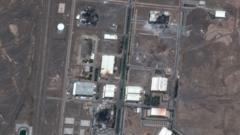The Israeli military has launched extensive strikes on Iranian targets, asserting its intent to dismantle Iran's military and nuclear capabilities, while Iran responds with missile attacks resulting in significant civilian casualties on both sides. The situation has raised fears of a prolonged conflict that could destabilize the region further.
Escalation of Israel-Iran Conflict Sparks Widespread Destruction and Humanitarian Crisis

Escalation of Israel-Iran Conflict Sparks Widespread Destruction and Humanitarian Crisis
As the war between Israel and Iran intensifies, both nations face escalating casualties and damages, pushing the conflict into an unprecedented phase of hostility.
In recent days, the conflict between Israel and Iran has escalated dramatically, marking a new and violent chapter in the two nations' longstanding enmity. As of June 16, 2025, Israel claims to have attacked the headquarters of Iran’s elite Quds Force, with reports of extensive damage in major cities across both countries.
The Israeli military's bombardment has targeted over 100 locations in Iran, focusing primarily on military and nuclear sites, resulting in casualties that have reportedly included at least 224 fatalities, according to Iranian health sources, alongside over 1,400 injured. In retaliatory strikes, Iran launched missile attacks on several Israeli cities, leaving a reported eight dead and nearly 100 injured, bringing chaos to urban areas such as Tel Aviv and Haifa.
Photographs and videos circulating on social media reveal significant devastation: shattered buildings, people trapped under debris, and rescue teams scrambling amid the wreckage. In Tel Aviv, residents sought refuge in underground shelters as sirens wailed, alerting them to incoming Iranian missiles. Reports noted that four people died when their Petah Tikva apartment building was struck, while additional fatalities occurred in Haifa, as Iranian missiles hit critical infrastructure, including oil refineries.
The fighting comes amid failed diplomatic talks concerning Iran's nuclear program, prompting fears of a broader Middle Eastern escalation. Both Israel and Iran have expressed no willingness to de-escalate, with Israeli military officials claiming to have achieved aerial superiority over Iranian skies. This shift may have systemic impacts on regional geopolitics, as increased military action suggests a determined effort by Israeli forces to prevent Iran from maintaining its enrichment processes necessary for nuclear weapons.
Israel's defensive strategy includes offensive strikes to minimize Iranian capabilities, while Iranian officials claim the country will persist in its defense against "aggression," even urging global actors to oppose Israeli military actions. The combative rhetoric suggests a grim outlook for potential diplomatic resolutions, as significant casualties and destruction mount on both sides.
In light of the ongoing conflict, U.S. involvement remains a looming possibility, as terror of wider repercussions for the region grows. Upcoming days may shift the strategies of both nations amid hopes for cessation, while humanitarian concerns echo through the cities bearing the brunt of this conflict's violence.
The unfolding situation highlights the intertwined fates of both nations, leaving citizens fraught with uncertainties as air raid sirens and missile alarms dictate their daily lives. With fears of a prolonged confrontation mounting and civilian casualties rising, the urgency for prompt humanitarian assistance and diplomatic intervention becomes increasingly crucial.
The Israeli military's bombardment has targeted over 100 locations in Iran, focusing primarily on military and nuclear sites, resulting in casualties that have reportedly included at least 224 fatalities, according to Iranian health sources, alongside over 1,400 injured. In retaliatory strikes, Iran launched missile attacks on several Israeli cities, leaving a reported eight dead and nearly 100 injured, bringing chaos to urban areas such as Tel Aviv and Haifa.
Photographs and videos circulating on social media reveal significant devastation: shattered buildings, people trapped under debris, and rescue teams scrambling amid the wreckage. In Tel Aviv, residents sought refuge in underground shelters as sirens wailed, alerting them to incoming Iranian missiles. Reports noted that four people died when their Petah Tikva apartment building was struck, while additional fatalities occurred in Haifa, as Iranian missiles hit critical infrastructure, including oil refineries.
The fighting comes amid failed diplomatic talks concerning Iran's nuclear program, prompting fears of a broader Middle Eastern escalation. Both Israel and Iran have expressed no willingness to de-escalate, with Israeli military officials claiming to have achieved aerial superiority over Iranian skies. This shift may have systemic impacts on regional geopolitics, as increased military action suggests a determined effort by Israeli forces to prevent Iran from maintaining its enrichment processes necessary for nuclear weapons.
Israel's defensive strategy includes offensive strikes to minimize Iranian capabilities, while Iranian officials claim the country will persist in its defense against "aggression," even urging global actors to oppose Israeli military actions. The combative rhetoric suggests a grim outlook for potential diplomatic resolutions, as significant casualties and destruction mount on both sides.
In light of the ongoing conflict, U.S. involvement remains a looming possibility, as terror of wider repercussions for the region grows. Upcoming days may shift the strategies of both nations amid hopes for cessation, while humanitarian concerns echo through the cities bearing the brunt of this conflict's violence.
The unfolding situation highlights the intertwined fates of both nations, leaving citizens fraught with uncertainties as air raid sirens and missile alarms dictate their daily lives. With fears of a prolonged confrontation mounting and civilian casualties rising, the urgency for prompt humanitarian assistance and diplomatic intervention becomes increasingly crucial.




















